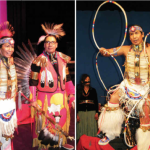Richard Walker, Indian Country Today Media Network
My bowling partner’s ball hugged the edge of the lane before curving into the pocket. He started game one with a spare, and followed with a strike and a spare in the next two frames.
My performance? Not so good.
Keep your eye on your mark, my partner reminded me. When I finally got a strike, he gave me a high five and was as happy as if he had gotten it.
My partner, Cosmo Castellano, is the winner of the Pepsi State Bowling Championship. He bowled a 202 high game and a 505 series to win the title in his age group May 19 at Pacific Lanes in Tacoma, Washington.
Some bowlers say he could be the next Earl Anthony, the Professional Bowlers Association Hall of Famer who hailed from Tacoma. Here’s the kicker: Cosmo is 7 years old.
Cosmo, Hawaiian/Filipino/Haida/Tsimshian, is the son of Zachary and Rosita Castellano of Tacoma and a member of the Argel family of Metlakatla, Alaska. Cosmo’s grand-uncle is the late Julian Argel, who served in the Office of Minority Affairs at the University of Washington, directed education and social programs for Native communities in Washington and Alaska, and helped develop curricula for Native education.

Cosmo is a leading youth bowler in Washington state. This year, he won the state Division 3 Classic Masters title; during practice, he bowled a 220, his highest non-league score. Of state Little Juniors League bowlers, he led the list of top 50 bowlers for 26 of 28 weeks of the 2012-13 season, and led in high scratch games (189), high scratch series (471), and high average (33 pins higher than the nearest competitor).
Rosita said her bowling phenom first rolled a ball down a lane at age 2. She and her husband were bowling and they heard a ball in the lane next to them. It was Cosmo.
The boy started bowling regularly at age 3. His dad, a competitive amateur bowler, started his son with a 6-pound ball his first year, and Cosmo was bowling with a 12-pounder by age 5-and-a-half. Cosmo now bowls three days a week, including six to eight hours on weekends, and competes in tournaments throughout western Washington. Cosmo has topped his dad 201-173 and 188-187.
To handle his 12-pound ball—only four pounds lighter than his dad’s—Cosmo uses a two-handed style similar to his favorite pro bowler, Jason Belmonte, 2009 PBA Rookie of the Year.
Rosita, a reading specialist at Gates High School in Tacoma, said the science of bowling engages her son’s curious mind. He likes the challenge of a spare, figuring out ball speed and amount of spin needed to pick it up. Cosmo likes the challenge of getting a knocking down a split, and once picked up a 6-7-10—easier to pick up because of the 6 pin, but a killer shot nonetheless.
Cosmo enjoys watching other bowlers on the lanes and on TV. His role models: Belmonte; Chris Barnes, the third bowler in PBA history to win Rookie of the Year and Player of the Year honors in a career; and Osku Palermaa of Finland, who’s bowled more than 50 perfect games.
“He’s made goals for himself,” said Rosita. “As a parent, you can’t ask for anything more for your child than for him to set goals and to self-assess [his progress].” One goal he’s set: A clean game, in which every frame has a strike or spare.
Cosmo has also learned valuable life lessons from the sport. “He had a rough spot in his early 5s,” Rosita said of Cosmo’s sportsmanship. “He’s learned to encourage other bowlers, to be collegial. He still enjoys the game even when he doesn’t bowl well.”
When he won the state championship, Cosmo’s parents asked him, “Do you know what you did? You’re the best bowler in the state,” Rosita said, “It didn’t faze him. It was nice to not see him gloat. He was more concerned about being with his friends.”
Cosmo is indeed a collegial player. When I left a hidden pin standing in a spare attempt, Cosmo said, “That was a sleeper,” and gave me five for a good try.
Cosmo applies the same discipline in school that he does on the lanes. He’s a first-grader at Brookdale Elementary School in Tacoma but participates in the third-grade reading program. He’s received several Bobcat Excellence awards (the bobcat is his school’s mascot) for attendance, courtesy and thoughtfulness. He studies Northwest Native culture through his school district’s Indian Education Program.
The money he and other youth bowlers win is placed by the league in a college tuition savings account, his mother said.
Cosmo and I closed out our third and final game with strikes in the 10th frame, and Cosmo finished in the lead by 37 pins.
I asked, and he shyly gave me his autograph. It’s not the first he’s been asked for. It likely won’t be his last.
Read more at https://indiancountrytodaymedianetwork.com/2013/05/27/haida-tsimshian-boy-one-top-bowlers-washington-state-149497





